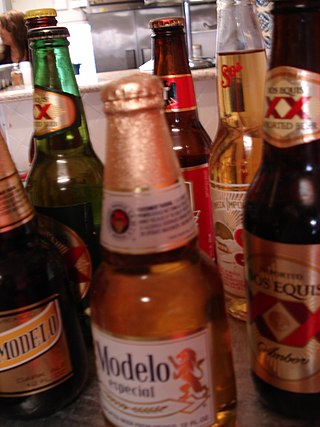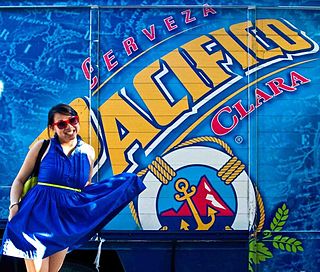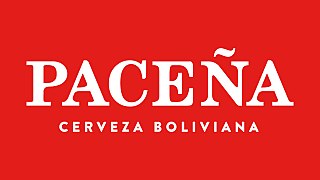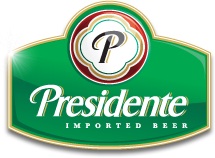Gallery
- Bieckert aviso
- Cerveceria Strasser Rosario 1885
- The first commercial brewery in Argentina was started by Baron Bieckert in Villa Adelina
- A beer in Salta – an Argentine city in the Andean foothills
The annual consumption of beer in Argentina is about 33 litres per person. [1]
There had been German immigrants in Argentina, since before 1871, but a change of immigration policies along the Volga and the imposition of military service caused a mass exodus of ethnic Germans to Catholic Argentina. In the 1881 census they were the fourth largest ethnic group in the country. There was money to be made from land purchase and parcelling, and the families were expecting home comforts. All the early breweries had owners with ethnic German names. [2]
The predominant brewery in Argentina is AB InBev with a 65% of the market, with brands such as Quilmes, Brahma, Budweiser, Corona and Stella Artois. The second largest brewery is Compañía de las Cervecerías Unidas with a 33% share, which produces Heineken, Schneider, Imperial and Isenbeck. The best selling brands are Brahma, Quilmes, Schneider and Imperial. [3]
This was the first beer to be brewed in Argentina. Emilio Bieckert (1837-1913) was of Alsatian origin, the border region between Germany and France, both countries with a strong beer tradition. Photographic evidence shows he was selling Bock beer, a strong beer developed by the monasteries in Bavaria, and Pilsner a lighter beer of Czech origin. Pilsner needs low temperatures to ferment correctly. A few years earlier Bieckert had opened the first ice manufacturing plant in the country.
Compañía de las Cervecerías Unidas bought the brewery in 2008.
Quilmes is an Argentine brewery founded in 1888 in Quilmes, Buenos Aires Province, by Otto Bemberg, a German immigrant in the early 1880s. By the 1920s it was the iconic Argentinian beer. Quilmes was the largest beer maker in Argentina in 1993. [4]
In 2002, Brazilian company Ambev bought 37.5% of Quilmes. Later, Ambev became part of InBev and eventually Anheuser-Busch InBev. [5]
There has been a considerable boom in microbrewing in Argentina since the start of the 21st century. As of 2019, there were 4,000 microbreweries in Argentina. [6] Some of the most notable Argentine craft breweries have their roots in the wave of German and Swiss immigration to the southern provinces of Río Negro and Neuquén in the late 19th and early 20th centuries. The city of Bariloche is a particular hotspot for craft brewing.

SABMiller plc was a South African multinational brewing and beverage company headquartered in Woking, England on the outskirts of London until 10 October 2016 when it was acquired by AB InBev. Prior to that date, it was the world's second-largest brewer measured by revenues and was also a major bottler of Coca-Cola. Its brands included Foster's, Miller, and Pilsner Urquell. It operated in 80 countries worldwide and in 2009 sold around 21 billion litres of beverages. Since 10 October 2016, SABMiller is a business division of AB InBev, a Belgian multinational corporation with headquarters in Leuven.

Ambev, formally Companhia de Bebidas das Américas, is a Brazilian brewing company now merged into Anheuser-Busch InBev. Its name translates to "Beverage Company of the Americas", hence the "Ambev" abbreviation. It was created on July 1, 1999, with the merger of two breweries, Brahma and Antarctica. The merger was approved by the board of directors of the Brazilian Administrative Council for Economic Defense (CADE) on March 30, 2000. The organization's headquarters are in São Paulo, Brazil. It is one of the largest companies by market capitalization in Brazil and in the Southern hemisphere.

History of beer in Mexico dates from the Spanish conquest of the Aztec Empire. While Mesoamerican cultures knew of fermented alcoholic beverages, including a corn beer, long before the 16th century, European style beer brewed with barley was introduced with the Spanish invasion soon after Hernán Cortés's arrival. Production of this beer here was limited during the colonial period due to the lack of materials and severe restrictions and taxes placed on the product by Spanish authorities. After the Mexican War of Independence, these restrictions disappeared, and the industry was permitted to develop. Furthermore, the arrival of German immigrants during the ephemeral Second Mexican Empire of elected Maximilian I of Mexico, born an Austrian archduke, in the 19th century provided the impetus for the opening of many breweries in various parts of the country.

Grupo Modelo is a large brewery in Mexico that exports beer to most countries of the world. Its export brands include Corona, Modelo, and Pacífico. Grupo Modelo also brews brands that are intended solely for the domestic Mexican market and has exclusive rights in Mexico for the import and distribution of beer produced by Anheuser-Busch. Until the 1960s, Grupo Modelo used red poppy flowers in most of its advertising.

Cerveza Pacífico Clara, better known as Pacífico, is a Mexican pilsner-style beer. Cerveza Pacífico is named so because the Pacífico brewery is located in the Pacific Ocean port city of Mazatlán, in the state of Sinaloa, México.

Brazil is the world's third largest beer market with total volume at 139 million hectoliters, and per capita consumption 61 liters in 2016.

Cervecería y Maltería Quilmes is an Argentine drink company founded in 1890 in the city of Quilmes in Greater Buenos Aires. The company was established by Otto Bemberg, a German immigrant, in 1890 as a beer manufacturer. Since 2002, Quilmes is owned by AmBev, the largest beer manufacturer in the world.

Oriental Brewery or OB is a South Korean brewery currently owned by AB InBev, and initially founded by Doosan Group.
Schneider is the brand of beer produced by the Compañía de Cervecerías Unidas Argentina (CCUA), or Company of United Beer Producers, in Spanish. The CCUA is as of 2006, the 3rd largest producer of beer in Argentina. It controls around 16% of the beer market in the country, and is the official importer of foreign brands Heineken and Budweiser in Argentina. It also imports and commercializes Corona and Guinness.
Cerveceria Nacional Dominicana (CND), is the primary beer producer in the Dominican Republic, the company is owned by AmBev and Grupo León Jimenes. It was founded in 1929 by the American entrepreneur Charles H. Wanzer. It was the first brewery in the Dominican Republic and the largest in the Antilles and Central America with sales of 3.8 million hectoliters. It first released its major brand Presidente in 1935, and has since expanded to other brands such as Bohemia Especial, Presidente Light and Ambar. The first two are pilsener beers that fall in the category of lager beers, and the latter is the company's first incursion into dark beer. Its current brewery complex was opened in 1951. It employs 2,500 people and produces up to 500 million liters of beer.
SABMiller was one of the top five global brewing companies, and had a range of over 150 beers, including international beers such as Pilsner Urquell, and Miller Genuine Draft, and local ones such as Gambrinus and Castle Milk Stout.
Anheuser-Busch InBev SA/NV is the largest beer company in the world. It had 200 brands prior to the merger with SABMiller on October 10, 2016. The combined ABInBev/SAB Miller entity has approximately 400 beer brands as of January 2017.

The primary beer brewed and consumed in Chile is pale lager, though the country also has a tradition of brewing corn beer, known as chicha. Chile's beer history has a strong German influence – some of the bigger beer producers are from the country's southern lake district, a region populated by a great number of German immigrants during the 19th century. Chile also produces English ale-style craft beers while also developing its own craft beer identity.
Anheuser-Busch InBev SA/NV, commonly known as AB InBev, is a Belgian multinational drink and brewing company based in Leuven, Belgium and is the largest brewer in the world. AB InBev has a global functional management office in New York City, and regional headquarters in São Paulo, London, St. Louis, Mexico City, Bremen, Johannesburg, and others. It has approximately 630 beer brands in 150 countries.
InBev was a brewing company that resulted from the merger between Belgium-based company Interbrew and Brazilian brewer AmBev which took place in 2004. It existed independently until the acquisition of Anheuser-Busch in 2008, which formed Anheuser-Busch InBev. InBev had operations in over 30 countries and sales in over 130 countries. In 2006, it had a market capitalization of €30.6 billion and net profit of €3.2 billion on sales of €13.3 billion.

CCU is a Chilean producer of diversified beverages founded in 1902. The company produces both alcoholic and non-alcoholic beverages, also operating in the food sector. They have operations in Chile, Argentina, Bolivia, Colombia, Paraguay, Uruguay and Peru.

Paceña is a Bolivian beer produced in La Paz, hence its name that means the one of La Paz. The beer is produced by CBN a company that dates back to 1877 and that controls 80% percent of the Bolivian beer market. Paceña is made at about 3600 meters above sea level with purified water from the Andes.
This article discusses beer in Central America.

Presidente is a brand of Pilsner beer that is owned and produced by Cervecería Nacional Dominicana (CND) at several breweries in the Dominican Republic. In addition to domestic consumption in the Dominican Republic, Presidente is exported to the United States, Panama, Honduras, Spain, Germany, Switzerland, Italy, Andorra, Aruba, Cuba, Curaçao, Antigua, Belize, Martinique, Guadeloupe, Turks and Caicos, The Bahamas, Saint Martin, British Virgin Islands and Puerto Rico. Varieties include Presidente, Presidente Light, Presidente Black, The One, Bohemia, Bohemia Light, Bohemia Especial. Bohemia Especial Light, Bohemia Light and Brahma